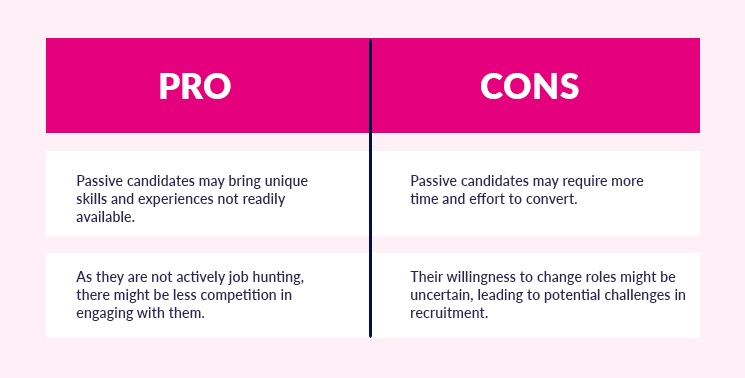Topics: Active candidate sourcing, Candidate Sourcing, Passive Candidate Sourcing
Posted on January 29, 2024
Written By Ranjana Singh

Active or passive candidate sourcing: which method is best to build a strong hiring strategy? As a hiring manager, this question might frequently cross your mind. But before we go further, let’s understand why making this decision is super important.
We all know a company’s strength comes from its people. Picking the right folks, making smart hiring choices, can really boost a business. That’s why recruiters need to know the kind of candidates they want before putting out a job ad.
Now, there are two main ways to source candidates: active and passive sourcing. Figuring out the difference can help recruiters find the best match for the job.
So, what’s the deal with active and passive candidates? Well, active ones are easier to find, but passive ones might be an even better fit, bringing in unique skills and perspectives. Recruiters should use different strategies to attract both types.
Active candidate sourcing means reaching out to people who are actively looking for jobs. These are folks who are actively applying to job ads, using job websites, and letting people know they’re available for work. An active candidate is someone actively searching for a job, whether they currently have a job or not. They’re often online, checking LinkedIn, signing up for job websites, sending applications, and being active on social media in their job hunt.
How to tell if someone is an active candidate:

Nobody has claimed that passive candidates are better than active ones, but let me tell you they make up a whopping 70% of the talent market. If your hiring strategy does not include recruiting passives you’re fishing from a very small pond.
Passive candidate sourcing is all about focusing on individuals who are currently employed or not actively searching for new opportunities. These potential candidates might not pop up on job boards, but they could be quite receptive to considering new roles if you approach them. The key is reaching out and engaging with them in a way that showcases the exciting opportunities your company has to offer. Passive candidates often bring a wealth of experience, unique skills, and a fresh perspective, making them valuable additions to your team. So, including them in your hiring strategy can significantly broaden your talent pool and lead to discovering individuals who may not have otherwise been on your radar.

Why do we need to choose? Can’t there be a good mix of both?
According to LinkedIn, only 30% of the global human resource population belongs to the category of active job seekers. An incredible 87% of job seekers are both active and passive candidates, open to new job opportunities. This means that those exclusively targeting active candidates and neglecting passive candidates lose the lion’s share of potential applicants. Thus, a sensible recruitment strategy balances the two treatments: recruiting active job seekers for the currently open roles and keeping in mind recruiting passive candidates as prospects.
Here’s how you can strike the right balance:
1. Define Your Needs: Assess the urgency and requirements of your hiring needs.
2. Build Relationships: Cultivate relationships with passive candidates over time to create a talent pool.
3. Utilize Technology: Leverage recruitment technology to identify and engage both active and passive candidates.
4. Continuous Evaluation: Regularly evaluate the effectiveness of your strategy and adjust based on results.
The search and hiring of active candidates are the most straightforward and traditional because they are actively looking for a new job, browsing various resources, and are ready to consider different offers. Here are several methods to identify and engage with active candidates:
1. Job Boards: Post your job openings on popular job boards like Indeed, Glassdoor, LinkedIn, and industry-specific platforms. Actively search and browse resumes on these platforms to identify potential candidates.
2. Company Careers Page: Maintain an updated and user-friendly careers page on your company website. Ensure that the application process is straightforward, encouraging active candidates to apply.
3. Social Media Recruitment: Leverage social media platforms like LinkedIn, Twitter, and Facebook to share job openings. Engage with relevant groups and communities to reach a broader audience.
4. Networking Events: Attend industry-specific conferences, seminars, and networking events to connect with potential candidates. Host or participate in career fairs to meet active job seekers in person.
5. Employee Referral Programs: Encourage your current employees to refer qualified candidates. Offer incentives for successful referrals to motivate your team to actively participate in the hiring process.
6. Recruitment Agencies: Partner with recruitment agencies to tap into their networks and databases of active job seekers. Provide clear job descriptions and requirements to streamline the candidate selection process.
7. Online Communities and Forums: Participate in or observe discussions on relevant online communities and forums. Platforms like Reddit or specialized forums can be sources for active candidates.
8. University and College Job Boards: Post openings on career services job boards at universities and colleges. Attend campus recruitment events to connect with students and recent graduates.
9. Email Marketing: Build an email list of potential candidates who have expressed interest in job opportunities. Send regular updates on job openings and company culture.
10. Utilize Applicant Tracking Systems (ATS): Implement an ATS to manage and organize candidate applications. Use features like keyword searches to identify active candidates in your database. Remember, the key is to be proactive in reaching out and engaging with potential candidates through various channels to ensure that your job openings reach the right audience.
Must Read: Global Candidate Sourcing : Key Steps For Success | Infographic
Passive candidate recruiting is a more complicated process as they are not actively looking for a new position. Thus, recruiters cannot get by with traditional job boards in this case. That is why they have to apply different hiring methods here, some of which are:
1. Social Media Networking: Use LinkedIn to connect with passive candidates. According to SHRM’s survey, 95% of recruiters use LinkedIn to reach out to those not actively job hunting but occasionally updating their resumes.
2. Employee Referrals: Encourage current employees to refer passive candidates from their professional network.
3. Attend Industry Events and Conferences: Participate in conferences, seminars, and industry events to meet professionals in person.
4. Utilize Recruitment Agencies: Partner with recruitment agencies that specialize in your industry. These agencies often have access to a pool of passive candidates and can assist in reaching out to them.
5. Create Compelling Employer Branding: Develop a strong online presence and showcase your company culture on social media and your website. A positive employer brand can attract passive candidates who are interested in working for a reputable and appealing organization.
6. Direct Outreach: Send personalized messages to potential candidates expressing interest in their skills. Highlight specific aspects of your company and the opportunities it offers.
7. Alumni Networks: Tap into alumni networks from universities or previous employers. Alumni may have valuable industry experience and could be open to considering new opportunities.
8. Professional Associations: Explore memberships in professional associations related to your industry. These associations often provide directories of members, including passive candidates.
9. Industry-Specific Forums and Blogs: Engage with discussions on forums and blogs related to your industry. Passive candidates might participate in these online communities, providing an opportunity for connection.
10. Advanced Boolean Search: Use advanced search techniques, including Boolean search strings, to refine online searches for passive candidates. This helps you target individuals with specific skills and experiences.
In summary, active candidates are proactive job seekers, always on the lookout for opportunities, while passive candidates, like chill cats, are already employed but open to new opportunities. Balancing both approaches is crucial in the quest for top talent. QX Global Group, a leader in the offshore recruitment market can help you find the best talent with bespoke candidate sourcing services. Our services transform your recruitment process, elevating your workforce. To learn more about our services, please email us at [email protected] or call us at +1 551 307 5522.
Originally published Jan 29, 2024 04:01:54, updated May 13 2025
Topics: Active candidate sourcing, Candidate Sourcing, Passive Candidate Sourcing